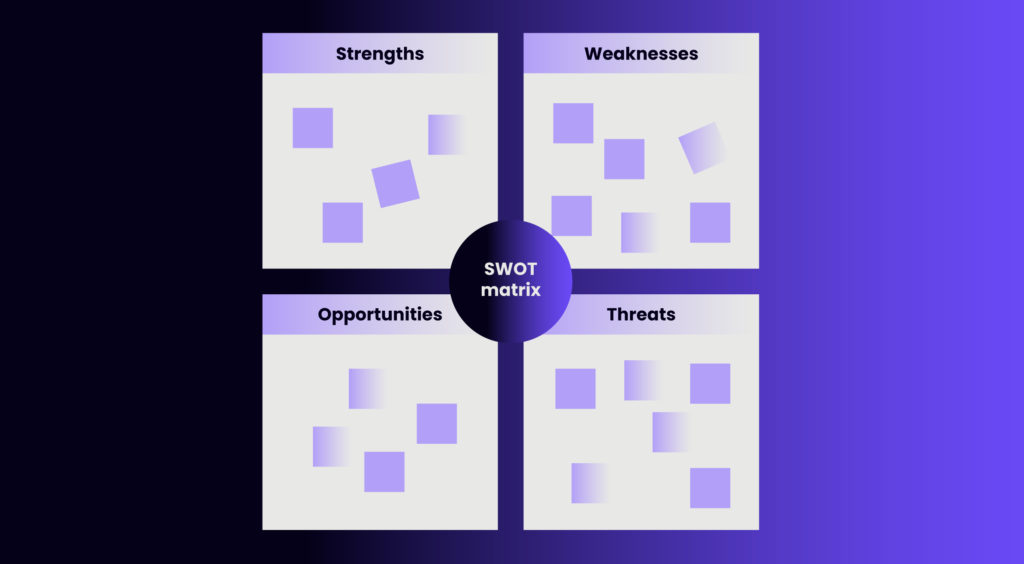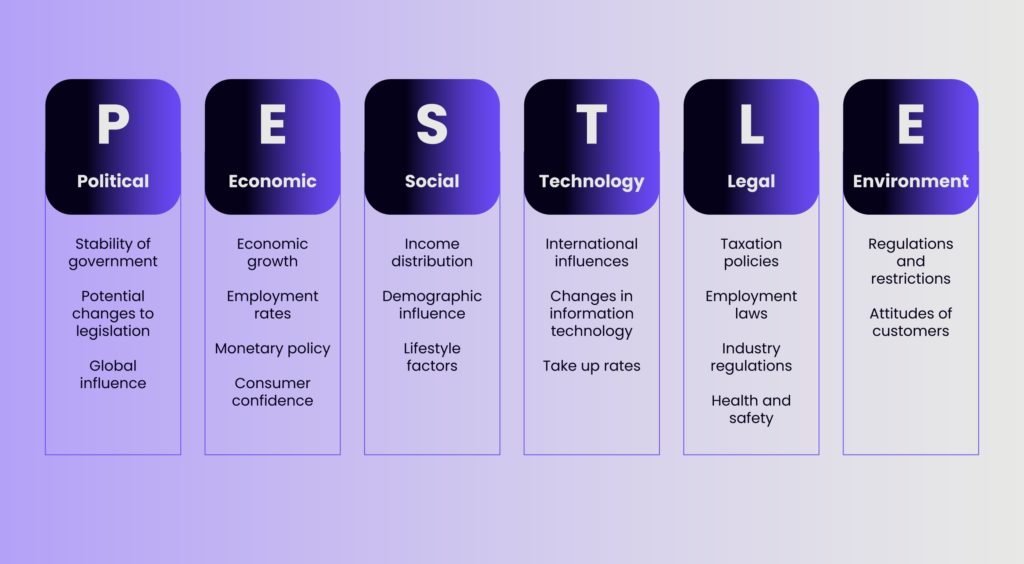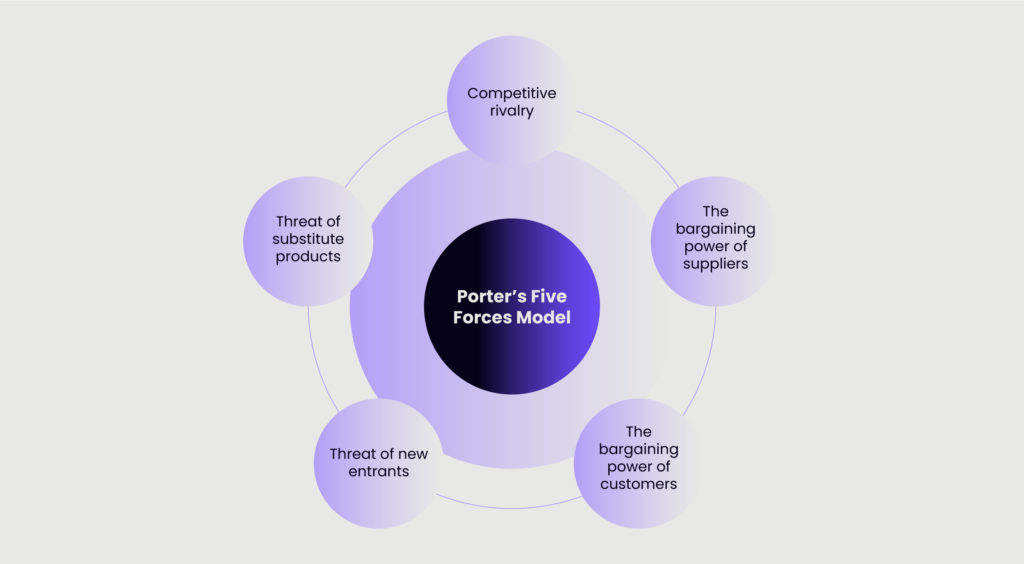Three Frameworks to Understand Your Competitive Environment
- Digital Strategy
In our previous blog post, we offered you a guide to understanding your competition. Now, we want to build on that piece and explain how to understand your company’s position within its broader competitive environment. We will do that by explaining three frameworks.
SWOT analysis, PESTLE analysis, and Porter’s Five Forces Analysis are competitive analysis frameworks that allow a company to assess their competition, and understand their own position in the market, in different ways.
SWOT stands for Strengths, Weaknesses, Opportunities, and Threats. A SWOT analysis is a useful way of analyzing these aspects of a business and helps companies formulate future strategies. PESTLE (Political, Economic, Social, Technological, Legal, and Environmental) analysis offers a bird’s eye view of the environment a business is operating in. Lastly, Porter’s Five Forces Analysis is a model that evaluates five competitive forces that form every industry and helps identify its strengths and weaknesses.
What is SWOT?
Albert Humphrey invented SWOT analysis in the 1960s. A SWOT report is often used internally to help a company set strategic goals, but it can also be used as part of a competitive analysis.

SWOT stands for strengths, weaknesses, opportunities, and threats. Below we will elaborate on these:
Strengths: Strengths are things that make a company stand out in the market it’s operating in. They are an integral aspect of an organization. Strengths are factors such as strong brand image, reduced debts, increased capital, loyal customer base, cash flows, geographic location, intellectual properties, etc.
Weaknesses: These can be categorized as factors that act as barriers to an organization when it comes to reaching its optimum level. Weaknesses are areas that a business needs to improve on to stand equally against its competitors. Examples include a weak brand image, increased debts, insufficient capital, etc.
Opportunities: These are linked to external factors that can offer a business a competitive edge. For instance, if there is a change in government policy that is directly linked to your product, it can determine the number of sales you’ll make.
Threats: Threats are external factors that can harm a company and adversely affect its revenue, brand image, and other such sources of value. Examples include increasing cost of production, limited supply of labor, rising competition, etc.
The value of SWOT analysis
A SWOT analysis can be used to home in on new business opportunities. It can also help identify which technologies are needed to keep up with competitors.
Building upon strengths and minimizing weaknesses is a key part of business. A SWOT analysis helps to do this. It also helps to minimize the weak aspects of a business before they worsen over time.
A sound understanding of internal factors such as a business’s strengths and weaknesses can influence the ability to seize opportunities and gauge threats. As tempting as it is to keep up with competitors, a business needs to have the capability to do that. A SWOT analysis is your savior in recognizing the company’s current potential.
SWOT Analysis Step-by-Step
Create a SWOT matrix
Create a grid first. Make a large square and divide it equally into four sections. Label each box accordingly: strengths, weaknesses, opportunities, and threats. All the information gathered will be filled in here.
Define objectives
When creating a SWOT analysis, decide which objectives are of primary importance as you need to include them in each section of the SWOT matrix. For instance, many people use a SWOT analysis when they’re looking to introduce a new product in the market. Make sure you which strengths, weaknesses, opportunities, and threats one will counteract by the end of the analysis.
Research
Conducting a SWOT analysis involves identifying a company’s strengths, weaknesses, opportunities, and threats. A good SWOT report will pull together information from sources of various types, including primary sources, such as company websites, financial statements, and annual reports; and secondary information, such as reporting and news items and product reviews as well as miscellaneous sites like Glassdoor.com.
Tip: Annual Reports are often produced by public companies and are often found in the “investor relations” section of a company’s website. US public companies are duty-bound to report financial statements to the Securities and Exchange Commission; search the SEC’s Edgar database for a company’s 10-K filing. European companies active in the US might submit a similar filing called a 20-F. UK companies can be researched on Companies House; while data quality will be richer for large companies, even modest-sized companies may provide useful data for SWOT purposes.
Strengths and Weaknesses
You can approach collecting and analyzing strengths and weaknesses in the same way, as they will often cover the same ground, for instance “revenue” could be a strength or a weakness. Here are some data points you can examine.
Financial performance
Revenue: the sum total of income generated from the sale of goods and services.
Net income/net profits: Revenue less operating expenses. An indicator of overall financial performance.
Investing cash flow: A company that can invest in its operations or share buybacks indicates a healthy financial position.
Financing cash flow: A company that can secure investment from banks and the capital markets indicates a healthy and attractive company.
For all the above, positive indicators are a strength, and the inverse are a weakness.
Marketing Performance
SEO: How well does the company rank for its top keywords?
Advertising: Does the company advertise? How well do they do it? Do they have a clearly defined brand? What makes them unique?
Word of Mouth Factors
Products: What are online reviews of products and services saying?
Employment: What do ex-employees say about the company?
Opportunities and Threats
Opportunities and threats are somewhat harder to discern as we move from quantitative data to qualitative. It is best to think of this pair in terms of external forces having a positive or negative impact on the business. Often, you will need to think about the company’s context within their industry. Luckily, financial journalists love discussing industry trends, so information should be reliably available.
Industry growth: Does the company exist in a growing industry that’s attracting external investment? Or is it in a low/negative growth industry?
Regulation: Are there any upcoming changes to a company’s regulatory environment that may be a threat or a benefit to the company’s operations?
Geographic: Is the company poised to enter a new geography?
Supply Chain: Is the company dependent on a fragile supply chain? Or
Trends: Is the company vulnerable to the fickle forces of fashion? Are demographic shifts likely to play into its hands?
PESTLE analysis
A PESTLE analysis is a tool that gives valuable insights into an industry’s overall macro environment. PESTLE stands for six factors—Political, Economic, Social, Technological, Legal, and Environmental—factors. These factors are helpful as they help to determine the external influences that can impact businesses. Furthermore, a PESTLE analysis can also be used to identify important risk factors for a SWOT analysis.

Below we examine these factors further:
Political: These are linked to the government’s control and influence over a country’s economy and market. Some examples of government factors are legislative or economic policies. Having a good knowledge of the political environment of a country is important because it can affect the industry in many ways. These include but are not limited to trade tariffs, increased taxation, fiscal policies, etc.
Economic: These factors directly affect a company’s long-term prospects. The economic environment a company operates in can impact its product prices and its supply and demand. Some examples of economic factors include rising inflation rates, unemployment, high foreign exchange rates, etc.
Social: Social factors include factors like cultural norms, health awareness, the rate of population growth, career attitudes, etc. These factors play a pivotal role in helping companies map out their marketing strategies, especially targeting specific customers.
Technological: These factors are linked to technological developments that affect a company’s operations. Take advanced technological advancements like artificial intelligence or deep learning, for example. If companies in this day and age fail to live up to these trends or aren’t fully aware of them, they might weaken their position in the market. PESTLE analysis deals with technological factors like infrastructure development, the pace of technological advancements, etc.
Legal: Legal factors are changes in legislative policies that affect employment, access to adequate resources, tax levels, etc. These factors are essential to consider as they influence the business environment companies operate in.
Environmental: These factors are linked to the ecological aspects of an environment. They include but are not limited to water disposal rules and regulations, energy consumption laws, etc. The environment aspect of PESTLE is especially applicable to industries like tourism, agriculture, etc.
Conducting a PESTLE analysis
The following steps will help simplify the process of conducting a PESTLE analysis:
Brainstorm: Reflect on the various facets of the business that are directly linked to PESTLE. Think about the positive or negative impacts of each and how to fit this data into the analysis. Consider seeking advice from experts outside the industry as well for a greater perspective.
Research: Conduct extensive research for each part of the PESTLE analysis. Look for supporting evidence for each insight. D&B Hoovers for example, is a data company that provides information necessary to analyze the risks involved in a business.
Evaluate: Rate the likelihood of every factor of the PESTLE analysis and how it can impact the business.
Refine: Repeat this process until you have reduced it down to a practical number of articulated and clear points in all the categories of PESTLE.
Porter’s Five Forces Model
Developed by Michael E. Porter in 1979, Porter’s Model of Five Forces model focuses on the five market forces that can determine the factors that affect profitability within a given industry. Using Porter’s model alongside a SWOT analysis can help a company make decisions on whether to increase its presence in its primary industry or invest in an adjacent industry.
Here are the five competitive forces highlighted by Porter:

Competitive rivalry
This force analyzes the intensity of competition in the market, which is dependent on the number of competitors and their growth potential. When there are a high number of competitors that are similar in size and market domination, rivalry is considered to be high. This is because consumers can switch to cheaper products. When rivalry is on the increase, competitors also have advertising and price wars.
Bargaining power of suppliers
This force aims to analyze the power of business suppliers. It determines how much control they have over increased prices of products. The force also assesses how many suppliers of raw materials are available. The fewer the suppliers, the more authority they have. Businesses with a wide range of suppliers are better off because they can control the prices of their products themselves, thus increasing profits.
Bargaining power of customers
This force deals with the ability customers have to lower the prices of products. This is influenced by the number of customers a company has and how much it would financially cost to discover new customers. A niche customer base means that customers can ask for lower prices. A company with a broader customer base will have more power to set higher prices for products, increasing their profits.
Threat of new entrants
The force of new entrants in a market can affect a company’s power. A company’s position, for instance, could be adversely affected if it costs less time and money for competitors to enter the market the company is operating in. An industry with a robust set of barriers limiting new entrants gives companies the power to raise their prices and increase their ROI (return on investment). Some factors that can restrict new entrants include but are not limited to government policies and capital requirements.
Threat of substitute products
Simply put, a substitute product is a product that another can replace in the market. Both products fulfill the same purpose. Companies that offer products with no substitutes have an added advantage as they can charge customers higher prices. When substitutes are available in the market, customers are more likely to buy them instead, thus weakening a company’s power. An example of substitute products can be iPhone and Samsung Galaxy.
Final thoughts
Part of running a business is having your competitive game intact. This means being aware of competitors’ moves, what makes them unique, and their respective growth patterns. The analytical frameworks we mentioned in this article will offer a deeper understanding of the competition that surrounds a business and great insights into how one can cope and make their business stand out. Competition is a multifaceted phenomenon, and in order to excel at tackling it, it’s essential to understand its many facets and complexities.
Windmill Digital offers a unique range of digital product strategy and design service that will make your products stand out in the market. To keep up with the latest updates, follow our LinkedIn page.


